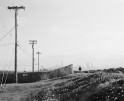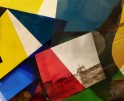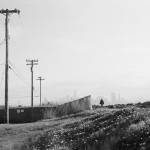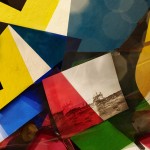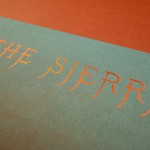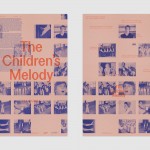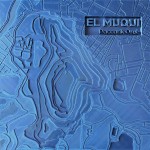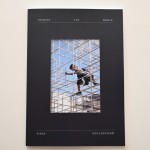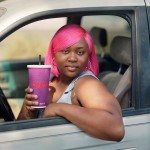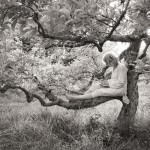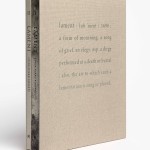Lindsay Buchman: Metaphors of Disorientation and the Malleability of Memory
One of the best parts of juroring an exhibition is discovering amazing work. I recently had the great pleasure of selecting text and image pieces for the Center of Fine Art Photography‘s exhibition, Words and Pictures. It was there that I discovered the work of Lindsay Buchman. She submitted her broadside, and the front and back, placed side by side, were the perfect marriage of words and pictures. The work held a certain pathos and intelligence. Today we share more of Buchman’s projects and interdisciplinary practice. In addition to her art making, Buchman is the founder of Seaton Street Press, an “independent artists’ books and publications project, publishing and distributing titles that examine the intersections of site, language, and memory, including archival histories, counternarratives, social identities, and geographies.”
An interview with artist follows.
Lindsay Buchman is an interdisciplinary artist, writer, and publisher based in Brooklyn, NY. She holds an MFA from the University of Pennsylvania and a BFA from California State University Long Beach. Exhibitions of her work include the Penumbra Foundation; San Francisco Center for the Book; TILT Institute for the Contemporary Image; LA Art Book Fair at The Geffen Contemporary, MOCA; New York Art Book Fair, MoMA PS1; Tokyo Art Book Fair, Museum of Contemporary Art Tokyo; SPRINT Milano, Spazio Maiocchi. She has participated in artist talks and panels at the School of the Art Institute of Chicago, the Institute of Contemporary Art Philadelphia, and the International Center of Photography. Her work is included in collections at the New York Public Library, SFMOMA, the Amon Carter Museum of American Art, Harvard University, and the University of Pennsylvania. She is a recipient of the Toby Devan Lewis Fellowship and the Flaherty Fellowship, and her work has been featured in Hyperallergic and The Hopper Prize Journal. Buchman has been an artist-in-residence at the Virginia Center for the Creative Arts, the Lower East Side Printshop, and the Institute for Electronic Arts at Alfred University. She is currently a Visiting Artist-in-Residence at Skidmore College. As an extension of her practice, she runs an independent artists’ books and publications project, Seaton Street Press, to collaborate with artists through publishing and distribution.
Instagram: @lindsaymbuchman
Instagram: @seatonstreetpress
My work responds to place through metaphors of disorientation and the malleability of memory in print and lens-based media, artist books, and writing. Central themes include the limits of language, the physiological relation between site and sight, and desire and loss. I position images and text to engage with divergent histories, dislocating perception through the form of the book, systems of knowledge, psychology, and mixed-race identity. This approach to rupturing one’s vision underpins how I work across media to puncture a sense of concrete time and space—both cognitive and embodied.
Working across analog and digital media in moving image, print media, and photography, I often depict image-making through an ethereal use of light, soft textures, a shallow depth of field, or an out-of-focus lens, gestures for what is out of reach or ineffable. While my work is typically autobiographical, I move between universal and subjective roles within each project. This process has explored numerous subjects spanning Los Angeles (CA), the Sixth Street Viaduct in LA, various sites in Philadelphia (PA), Pennsauken (NJ), Mancos (CO), found seascapes from the US and beyond, and most recently, Orange County (CA). Many of these projects position the sites in relation to subjects who stand in as characters, blurring the boundaries of creative non-fiction while using found and constructed archives. Within each project, geography textures the surroundings as an embodiment of disorientation. In this past-present connection, memory drifts between multiple environments, interpersonal relationships, and philosophical questions of meaning and knowledge. – Lindsay Buchman
Tell us about growing up and what brought you to photography.
Growing up, I was surrounded by photography by a mother who archived everything, which imprinted on my relationship to the archive, memory, and the role of indexing; this brings up all kinds of associations to the family album, analog photo history, the evolution of camera apparatuses and obsolete media, and photography as a mnemonic device. In hindsight, I thought nothing of this, but as a practitioner in the present, I can’t help but wonder how these early interactions have left traces on my associations with creating images as an artist. I began using a camera in my work around 2007 as a tool for image-making in printmaking, but it took until 2015 to admit I worked in photography. My relationship with photography has always been through printmaking, so I was delayed in accepting that I was perhaps also a photographer. I integrated photographic processes in print media early on in my career, then moved toward digital and analog photography around 2015 in graduate school, where I finally gave myself permission to print digital photographs on their own, unmediated. Still, I struggle with this relationship of leaving an image alone. Usually, I find myself working back-and-forth between print media and lens-based media, at the in-between of both print and photographic practice. E.g., screen prints from Super 8 film stills, risograph prints from HD video stills, digital photographs printed on lustrous rag paper to change the texture of the image, or digital photographs printed on silk Habotai to be constructed more as objects.
When did you begin to use text in your artwork?
I began using text in my work around 2006 or so. I then went through a long phase of burying text in images or objects to be indecipherable. Hearing feedback from an undergraduate professor about this habit, I began thinking about why I kept veiling text that was vulnerable. From there, I flipped and spent the rest of graduate school with text on the surface, with text as diaristic and confessional as a methodology. My work became about writing and reading, text-as-image, and moved toward language and communication as central subjects; these approaches are still foundational to how I create work all these years later.
Can you talk about your broadside?
The broadside included in Words & Pictures is from a body of work titled SUNSTRUCK, a print and lens-based media project, including archival photographs and writing triangulating land and seasickness, the horizon line, and the language of distance and desire. The project includes a 1000-word essay, an artist book with 49 figures from 1916-2018, and notes on provenance, engaging the physiological nature of disorientation while calling into question the mutability of time, photography, and sight. The broadsheet, titled ‘You were always somewhere else,’ is a text reference from my essay, ‘For Seasickness (every love has its landscape): A Meditation on the Physiological Nature of Loss, Distance, and Desire,’ in the artist’s book. In the essay, ‘You were always somewhere else’ is the footnote to the first sentence in the writing: “Sunstruck. [It was] the kind of light that could make you remember what you lost.” It is a direct reference to a partner who is dissociative and ‘always somewhere else,’ but it also refers to the “I” as the writer, referencing longing (longing also being a position of being somewhere else). The final footnote dovetails with the opening sentence, “In an instant, sunstruck—the flash of light that dissolves as quickly as it came, like desire, reaching back in to disrupt your perception of linear time,” which concludes with the footnote, “This wasn’t meant to hurt you.” The intention is that memory can flood us, pull up deep associations with the past in the flash of a light, a scent, an image, the intonation in the way a word is pronounced—all of it capable of conjuring a past-present, future-present, that the essay writes about. The writing is at the heart of the entirety of this project; it includes a reference to a medical paper on land and seasickness, connecting theories of motion sickness to antiquity while positing that looking to the horizon is an illusion for curing the vestibular disturbance (the inner ear’s dislocation in space) because the horizon is not static but relied on for creating a stable sense of ground. The broadsheet anchors the text-as-image with figures (archival and constructed photos from the book), best summed up as: “The proclivity to use the lens to preserve information constructs an archive like a home—a residence for the texture of memory—but it is a story about a home that is constantly changing. This mutability is the crux of the archive; it is always already somewhere else, repositioned.” I wrote this essay thinking about desire and longing, anxiety and uncertainty, how meaning is made, and how we remember and forget, explored through metaphors of the sea.
‘You were always somewhere else’ is a double-sided, folded newsprint, open edition, printed and published in 2019. When exhibited, it is presented as a take-away stack on a wood pedestal.
What comes first, the idea for a book project or thinking about an exhibition?
It depends on the project, but I usually think about books and exhibition/installation formats simultaneously. Sometimes, one form will come forth faster than the other, though. I typically work on projects for years at a time, often across a range of media, including video/film, writing, artist books, photography, works on paper, and installation, so the media usually determines how the project is shaped.
Tell us about Seaton Street Press.
Seaton Street Press is my independent artists’ books and publications project, publishing and distributing titles that examine the intersections of site, language, and memory, including archival histories, counternarratives, social identities, and geographies. The press is a bit itinerant: Its name is a dedication to my old studio in Los Angeles, but the press was based in Philadelphia from 2018-22, then briefly in Hudson for 2023, and now in Brooklyn. SSP is an extension of my artistic practice and reflects my interests formally and conceptually, mainly through the work of photographers and image-makers. A significant portion of the press is committed to publishing Latine and underrepresented narratives, and many publications connect with migration, gentrification, and familial archives.
Who or what is inspiring you lately?
New Poetics, a photo imprint by Nechama Winston and Cristina Velasquez; Raymond Meeks’ book The Inhabitants [MACK] and the presentation of this work in ICP’s Immersion exhibition; Myriam Boulos’ book What’s Ours [Aperture]; Pier 24’s final exhibition, Turning the Page, notably for the work of Rose Marie Cromwell, Rinko Kawauchi, Donavon Smallwood, and Vasantha Yogananthan. I am also feeling inspired by the work of LibroMobile Arts Cooperative, established by Sarah Rafael García in Santa Ana, California, for their incredible commitment to artists of color in Orange County (CA), digital archiving, and anti-gentrification efforts for their local community.
What’s next for you?
I’m working on two long-term projects: ‘Stratagems (Orange County)’ [2019-present] and ‘And to be held’ [2020-present]. ‘Stratagems’ considers Orange County, California’s history of landholdings, subdivisions, conservatism, and underrepresented narratives through my lens as a mixed-race Chicana and a transracial adoptee. It is a multimedia autoethnography, responding to the relationship between home, place, and belonging, examining how the specificity of geography shapes place-based racism. ‘Stratagems’ utilizes research and archival materials, including photographic negatives from the 20th century, combined with the iconography of the Valencia orange, a symbol for the County’s name and an icon of migrant labor in its farmlands, contrasted by image-making from regional locations, parklands, coastlines, and neighborhoods that comment on the preservation of ‘natural’ land within the southernmost part of the County. Part of the project will be featured in a forthcoming exhibition at Southern Exposure curated by tamara suarez porras. I will also be in residence for this work at Alfred’s Institute for Electronic Arts’ Print Media residency later this fall. Ongoing research is being conducted at the University of California Irvine’s Special Collections Library for The Orange County & Southeast Asian Archive to complete a large-scale artist book in 2025, coinciding with oral histories, video/film, photography, and works on paper.
‘And to be held’ includes a film essay, artist book, and photographs focused on the Philadelphia region through cinematic explorations of domestic space, light, changing seasons, neighborhood surroundings, and the examination of relational subjects not pictured but alluded to through language and fragmented dialogue. The book utilizes writing to underscore epistolary forms of communication—text broken up from letters, text messages, and notes—reflecting on what is often out of view from the public’s perception of our innermost relationships. Examining questions like: How do the nuances of gender, sexuality, and intimacy hide within the structure of the home? Where do we find our most embodied selves, within and outside partnership? And where do these traces reside once the structure has been disassembled? The project explores themes of loss, change, relational dysfunction, transgression, hope, and grief to visualize the many permutations relationships take, troubling the relation between surface and subtext. An element of this project will be published in a forthcoming book with National Monument Press’ photographic series, Dodeca Meters, released later this fall.
SUNSTRUCK contains archival photographs and writing triangulating land and seasickness, the horizon line, and the language of distance and desire. Including a 1000-word essay, 49 figures from 1916-2018, and notes on provenance, SUNSTRUCK, engages the physiological nature of disorientation while calling into question the mutability of time, photography, and sight.
Posts on Lenscratch may not be reproduced without the permission of the Lenscratch staff and the photographer.
Recommended
-
Andrew Waits : The Middle DistanceDecember 20th, 2025
-
Photography Educator: Juan OrrantiaDecember 19th, 2025
-
Aaron Rothman: The SierraDecember 18th, 2025
-
Eli Durst: The Children’s MelodyDecember 15th, 2025
-
Paccarik Orue: El MuquiDecember 9th, 2025

![[1] Lindsay Buchman_Somewhere else_2019](http://lenscratch.com/wp-content/uploads/2024/08/1-Lindsay-Buchman_Somewhere-else_2019.jpg)
![[2] Lindsay Buchman_Absent-present ground_2019](http://lenscratch.com/wp-content/uploads/2024/08/2-Lindsay-Buchman_Absent-present-ground_2019.jpg)
![[3] Lindsay Buchman_Always already lost_2019](http://lenscratch.com/wp-content/uploads/2024/08/3-Lindsay-Buchman_Always-already-lost_2019.jpg)
![[4] Lindsay Buchman_Seasickness (part three)_2019](http://lenscratch.com/wp-content/uploads/2024/08/4-Lindsay-Buchman_Seasickness-part-three_2019.jpg)
![[5] Lindsay Buchman_Seasickness_(part-one)_2018](http://lenscratch.com/wp-content/uploads/2024/08/5-Lindsay-Buchman_Seasickness_part-one_2018.jpg)
![[6] Lindsay Buchman_StratagemsRelocated_2021](http://lenscratch.com/wp-content/uploads/2024/08/6-Lindsay-Buchman_StratagemsRelocated_2021.jpg)
![[7] Lindsay Buchman_StratagemsRelocations_2021](http://lenscratch.com/wp-content/uploads/2024/08/7-Lindsay-Buchman_StratagemsRelocations_2021.jpg)
![[8] Lindsay Buchman_Stratagems_2023](http://lenscratch.com/wp-content/uploads/2024/08/8-Lindsay-Buchman_Stratagems_2023.jpg)
![[9] Lindsay Buchman_EverythingIveEverLovedNo4_2023-24](http://lenscratch.com/wp-content/uploads/2024/08/9-Lindsay-Buchman_EverythingIveEverLovedNo4_2023-24.jpg)
![[10] Lindsay Buchman_TodoEverything (#4)_2024](http://lenscratch.com/wp-content/uploads/2024/08/10-Lindsay-Buchman_TodoEverything-4_2024.jpg)
![[11] Lindsay Buchman_TodoEverything (#5)_2024](http://lenscratch.com/wp-content/uploads/2024/08/11-Lindsay-Buchman_TodoEverything-5_2024.jpg)
![[12] Lindsay Buchman_Stratagems (Lemon Tree + Cloud), no. 89_2024](http://lenscratch.com/wp-content/uploads/2024/08/12-Lindsay-Buchman_Stratagems-Lemon-Tree-Cloud-no.-89_2024.jpg)
![[13]Lindsay Buchman_Stratagems (Orange Branch Containing Fruit, no. 54)_2024](http://lenscratch.com/wp-content/uploads/2024/08/13Lindsay-Buchman_Stratagems-Orange-Branch-Containing-Fruit-no.-54_2024.jpg)
![[14] v](http://lenscratch.com/wp-content/uploads/2024/08/14-Lindsay-Buchman_Suspended-and-yet_2022.jpg)
![[15] Lindsay Buchman_DamageWithoutInjury_2017](http://lenscratch.com/wp-content/uploads/2024/08/15-Lindsay-Buchman_DamageWithoutInjury_2017.jpg)
![[16] Lindsay Buchman_Suntruck_2019](http://lenscratch.com/wp-content/uploads/2024/08/16-Lindsay-Buchman_Suntruck_2019-651x651.jpeg)
![[17] LindsayBuchman_Sunstruck_2019](http://lenscratch.com/wp-content/uploads/2024/08/17-LindsayBuchman_Sunstruck_2019-651x463.jpg)
